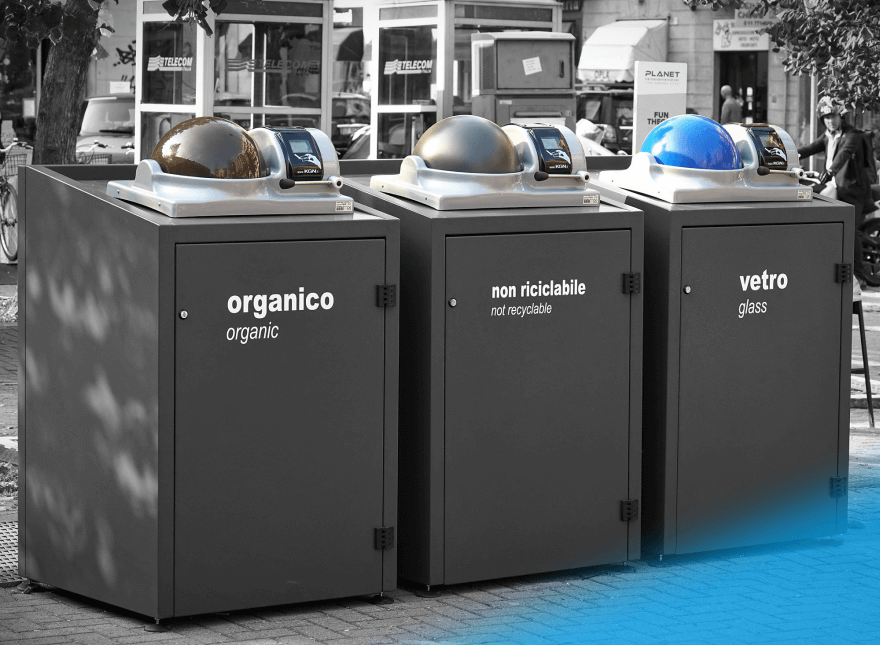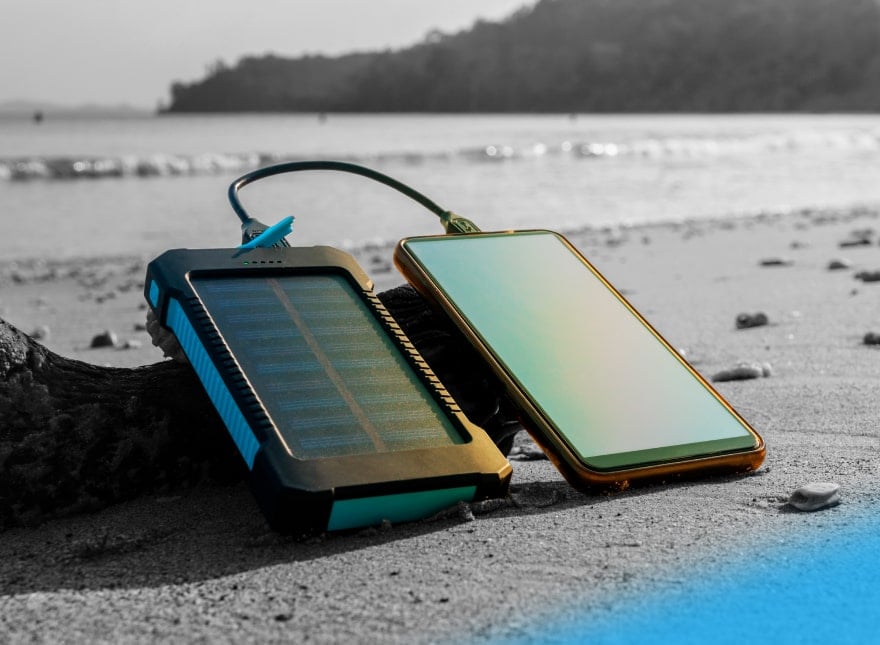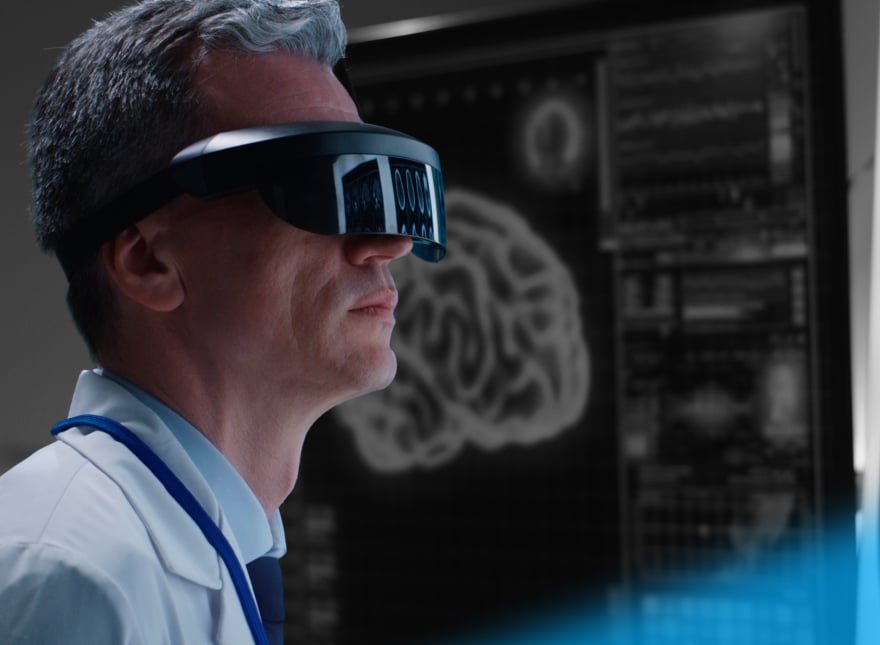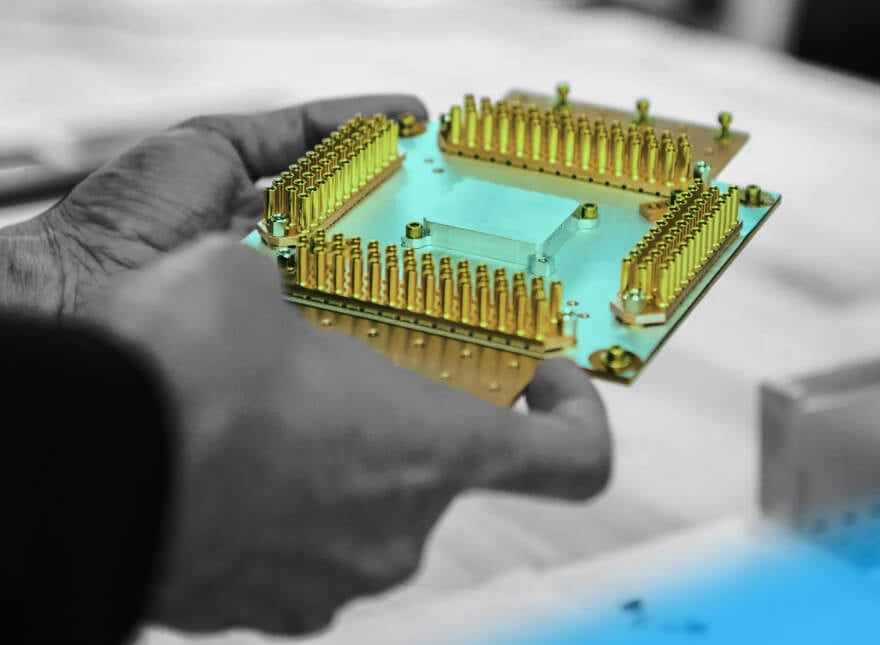Check out our latest blog article: From component to enterprise – modular robotics done right.
5 Metaverse Business Ideas for Startups and Enterprises

The metaverse market is in its infancy but growing at high speed. While it started out as a way to game, today, it’s more than just a computer game with avatars interacting in a cyber world. More and more people are entering the metaverse to socialize, work, and make purchases. For businesses, it’s a totally new niche with the potential to generate new revenue streams. These are unique times for tech companies that want to get ahead of the game.
This article is an overview of promising metaverse business opportunities for startups and enterprises. You’ll find out which key market drivers and areas of use to focus on to capitalize on this trend. We’ve also highlighted metaverse startups and other companies that have already been successful in terms of money and recognition. Your project could be next.
Perspectives and Drivers of the Metaverse Market
The metaverse works as a computer game where users are 3D avatars in a virtual space. These avatars simulate real lives—they work, entertain, buy things, and socialize. For the metaverse to exist and spread, there is a combination of technologies behind the scenes. The concept relies on AR and VR solutions. It also utilizes other technologies like blockchain, AI, and computer vision. Here are the factors helping to drive the metaverse’s expansion today:
- The spread of VR headsets. Virtual reality headsets are essential for entering a virtual world. In 2021, Oculus, the market leader, sold 8.7 million units—78% of all VR headset sales that year. But more competitors are incoming. Tech giant HTC has created a high-end VR headset to compete with the market leader. Apple is also working on its mixed reality (MR) headset. This headset won’t require external controllers; users will be able to just look at something on screen to select it and then pinch their fingers together to activate it.
- The potential of AR glasses. Today, augmented reality glasses are mainly used to take pictures, record videos, and make phone calls. Examples include Meta’s Rayban Stories and Snap’s Spectacles. At the same time, solutions like Microsoft Hololens already assist professionals in their day-to-day tasks. For example, mechanics at Audi and Mercedes use Hololens to look at their car engines virtually. As for the metaverse, AR glasses can improve the shopping experience in a virtual space.
- Sophisticated 3D graphics. For its users to become completely immersed in a virtual space, the metaverse needs high-fidelity graphics. This means there’s a need to enhance 3D graphics. For this reason, Meta is ready to invest millions of dollars into professionals that will develop for Oculus and their VR game Horizon Worlds. Microsoft is trying to acquire Activision Blizzard to access developers that build immersive experiences.
- Web 3.0 and blockchain. Web 3.0 stands for the web’s new direction, where most users are connected through a decentralized network and have access to their own data. Blockchain is at its core, with new applications and services based on this technology. In fact, Web 3.0 and blockchain allow users to interact in a virtual space like they would in the real world. One aspect of this is buying virtual assets as non-fungible tokens (NFTs). Users can buy a wide variety of art and collectibles.
Although the metaverse is still conceptual, the point at which it will no longer be treated as science fiction is just around the corner. The following statistics are proof:
- Gartner predicts that by 2026, one in four people will spend at least one hour a day in the metaverse to work, shop, and entertain.
- According to Statista, even in a conservative estimate, 15% of the digital economy will be shifted to the metaverse by 2030. An optimistic estimate says this figure will be 35%.
- Finally, Markets and Markets estimates that the global metaverse market size will see a 690% increase between 2022 and 2027.
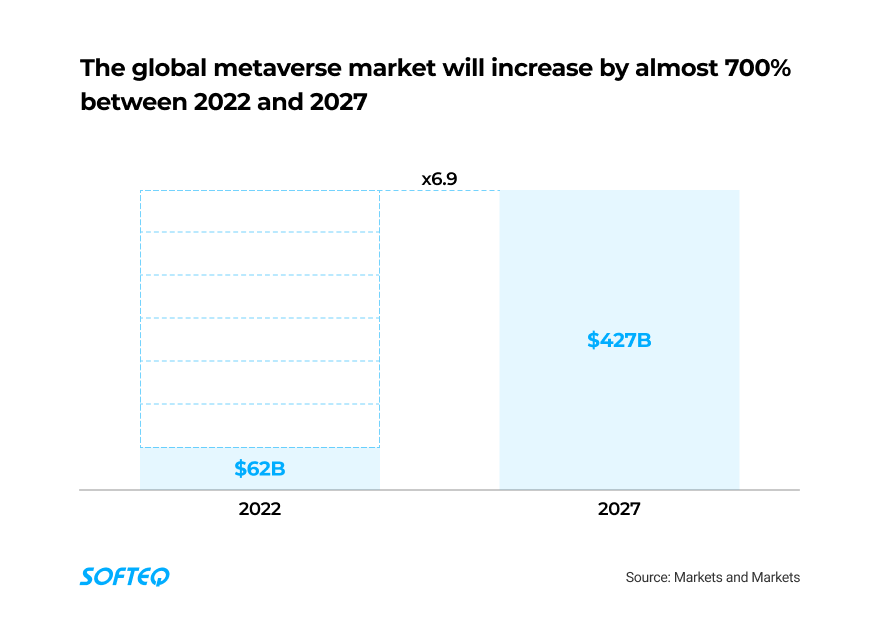
There’s a lot of potential for metaverse business opportunities that aren’t just related to gaming. Check out these five metaverse business ideas with real-life examples as proof.
Idea 1. The Metaverse in Retail and eCommerce
There are two ways in which the metaverse is bringing eCommerce to the next level. First up is using AR to boost the sale of real-world goods. Retailers introduce products to their customers in 3D to help them make purchases. Examples include a mobile app from IKEA that virtually “places” products within a space and Nike’s app for choosing the right shoe size. It’s also becoming more common for retailers to place ads in computer games. For example, the video game Football Manager has virtual billboards showing advertisements for Coca-Cola, Samsung, and Volkswagen.
Second, we have the sale of virtual items through eCommerce platforms. In the coming years, virtual designer products and real estate could become the new reality. Some users already own virtual assets thanks to blockchain technology. Meanwhile, some gamers customize their avatars in the metaverse with accessories and clothing from real brands. An example of this is a digital bag from Gucci. It was sold on the online game universe Roblox for $4,000.
Real-life example. The famous sports manufacturer Nike is one of the metaverse’s early adopters. In 2021, they created their micro metaverse, Nikeland, on the Roblox platform. The 3D environment is inspired by the original Nike headquarters. Here in this virtual space, players can try on virtual products with their avatars and buy tokenized items as digital assets. Visitors to the digital showroom can also create their own Nike-branded accessories from scratch.
Nikeland is also a space for sports fans and gaming. Users can play soccer and basketball for a chance to earn rewards and prizes. They can also create their own mini-games.
As of March 2022, seven million people had already visited Nikeland. For Nike, marketing in the metaverse is part of its marketing and branding strategy for the coming years. Nike even acquired RTFKT, a company that creates virtual sneakers.
Idea 2. The Metaverse in Sports and Entertainment
The metaverse offers lots of opportunities for innovation in sports and entertainment because audiences are not limited by their locations. But virtual events aren’t anything new. Back in 2019, Fortnite, the online video game, hosted a virtual Marshmello concert. There were 10.7 million online attendees. During the concert, the virtual avatar performed live on a stage built within the game.
However, the metaverse is more than a space for virtual concerts and festivals. It even offers virtual meet-and-greets with celebrities. Fans can ask questions and take virtual selfies in the metaverse. Theme parks can also create virtual clones in the metaverse’s 3D space where visitors can enjoy interactive paths with immersive experiences and games. Similarly, museums can offer virtual 3D exhibitions within the metaverse.
In the field of sports, teams and stadiums can organize virtual events that make fans feel like they’re at a live game. This allows people from all over the world to cheer for their favorite players in real time. Teams can also create digital merchandise for fans, like collectibles. Manchester United is already doing this. Plus, athletes can use the metaverse to access virtual training programs and coaches from all over the world.
Real-life example. The National Basketball Association (NBA) is more involved in the metaverse than other sports leagues. It even has a partnership with Meta. Today, there are more than 50 live NBA games in VR on the Meta Quest platform. Users can also access game highlights, recaps, and archived content. Since March 2023, fans of the league have been able to dress their avatars in NBA apparel.
The NBA also teamed up with Google to invite fans to the Google Pixel Arena, an immersive 3D metaverse. Within the NBA app, users can pick a game to enter and immerse themselves in a 3D virtual arena. Gamers can create their own avatars and outfit them in their favorite team’s kit.
The basketball league also created the concept of a virtual instructor. In the 2022 All-Star Weekend, the NBA commissioner, Adam Silver, introduced Coach Nat, a metaverse basketball coach. The idea is that the 3D trainer can teach the game to anyone in the metaverse.
Idea 3. The Metaverse in Healthcare
The metaverse has the potential to revolutionize the healthcare sector in a variety of ways. One notable example is telemedicine, which became increasingly popular during the pandemic. Less than half of healthcare facilities were able to provide remote treatment before 2020. Now this figure has skyrocketed to 95%, and the metaverse can transform telemedicine even further. For example, patients and doctors can interact as if they were in the same room, no matter their location, with the help of VR.
But experts have pointed toward several other promising use cases for AR and VR in healthcare. One of them is virtual therapy. VR is already helping psychiatrists treat patients with anxiety in aversion therapy sessions. Likewise, a safe, controlled virtual environment could help patients overcome fears and phobias. A real-world situation can be created in a virtual space where patients can interact with avatars.
The technology can also aid medical training. For example, a virtual surgery room can be used to train surgeons on new procedures or techniques without the risks involved with real-life surgery.
AR and VR can also help with rehabilitation. Patients can improve their mobility and function with virtual physical therapy. The metaverse makes it possible to recreate a real-life scenario in a virtual world. For example, it can simulate walking on uneven terrain or climbing stairs.

Real-life example. The metaverse for healthcare is still just a concept, but more initiatives are coming. One notable example is Latus Healthcare, a UK-based digital occupational health provider. They are creating a VR hospital environment that requires the user to wear a headset. In this virtual space, patients can get consultations and access physiotherapy services. For example, doctors can use computer vision cameras to explore damaged joints and keep an eye on a patient’s progress to recovery.
The solution will also store medical records using blockchain. It has distribution databases in its core, which cuts the risk of data being stolen. Usually, health records are stored on more vulnerable centralized servers.
With its virtual hospital, Latus Healthcare has ambitious plans to treat one million patients daily.
Idea 4. The Metaverse in Real Estate
Virtual real estate is skyrocketing. Since Facebook rebranded itself as Meta in 2021, the value of real estate in the metaverse market has increased dramatically. Take a look at Decentraland, one of the four major metaverse platforms. Back in December 2017, it sold its first parcels of land for $20 each. Four years later, in December 2021, the average price went up to $12,000. In general, the prices of virtual land plots vary depending on the platform—but this trend is common. The global demand for virtual real estate is expected to increase 10 times between 2020 to 2025 and reach $3.6B.
Real estate in the metaverse is made up of parcels of land that exist in virtual spaces. Platforms like Decentraland sell virtual plots that people can develop. In the business context, brands buy up spaces to create virtual stores. For example, Everyrealm built an entire virtual shopping district called Metajuku. Interestingly, the company was inspired by Harajuku shopping district in Japan. This land package in Decentraland was sold for $913,000 in June 2021.
Another metaverse platform—The Sandbox—is particularly popular with celebrities. For example, the rapper Snoop Dog built an interactive metaverse, the Snoopverse, there. Anyone can be his virtual neighbor if they buy a parcel of land. In 2022, an anonymous user paid $450,000 to virtually live by the celebrity.
At the moment, there are four major metaverse platforms—Decentraland, The Sandbox, Cryptovoxels, and Somnium. Together, they offer more than 268,000 parcels of land.
Real-life example. One of the biggest real estate sales in the metaverse is a property bought by Republic Realm, a metaverse real estate investor. They paid $4.3 million for the land from The Sandbox to build 100 islands with villas and a boat market. On the first day, Republic Realm sold 90 of them for $15,000 each. Later, some of the parcels went up for resale at over $100,000.
Idea 5. The Metaverse for Enterprises
The metaverse has the potential to transform various aspects of business operations, including collaboration. Distributed teams can work on the same projects in a virtual space. For large enterprises with thousands of employees, this can save time and cut travel expenses.
“I predict most virtual meetings will move from 2D camera image grids,” wrote Bill Gates in his blog. “The idea is that you will eventually use your avatar to meet with people in a virtual space that replicates the feeling of being in an actual room with them.”
Training is another area where the metaverse can make a significant impact. In a simulated environment, the team can practice their skills. This can be useful for industries that need hands-on training, such as manufacturing or healthcare.
The metaverse can also be used to prototype and develop products. With the help of VR, it’s possible to create realistic simulations for product design and minimum viable product (MVP) testing. As a result, enterprises can visualize and iterate on new products and ideas quickly. Plus, the team members from different locations can work on the same 3D model. There are no geographical boundaries.
Real-life example. The metaverse for enterprises is still at the concept level, and several car manufacturers are already testing it out. One of them is Hyundai Motor Company. They teamed up with Unity, a platform for developing real-time 3D content, to create a meta-factory. It’s supposed to be a digital twin of a physical factory supported by a metaverse platform. This meta-factory will allow Hyundai to test-run a factory virtually and use insights to optimize operations. Plant managers can resolve issues in a virtual arena without visiting the plant.
Growing Prospects for Metaverse Startups
The metaverse might seem like a risky idea, but big companies like Microsoft and Meta are already taking it seriously and investing billions. Non-tech brands like Coca-Cola and Nike are creating their digital products with the metaverse in mind. They are more interested than ever in partnerships with companies skilled in VR, blockchain, and 3D. Here are just some transactions from over the last years:
- Warner Music Group teamed up with the Sandbox platform to launch the first music-themed world in the metaverse. They also allied with DressX, a digital fashion startup, to enable artists to create digital wearables and merchandise for fans.
- Sony bought out Beyond Sports, a developer of real-world data for 3D animations.
- Mozilla acquired Active Replica, a US-based virtual spaces and events startup.
- From 2022, Microsoft has been trying to acquire Activision Blizzard, one of the largest video game publishers in the world. The deal has not yet been approved due to international regulators. Some claim the merger would hinder competition. Otherwise, it could be the largest video game acquisition in history.
The metaverse was also at the center of the Consumer Electronics Show (CES) this year. Some of the most prominent tech innovators (and CES honorees) from 2023 include the following:
- Tunable lens insert for VR or MR headset from VOY Glasses. This insert allows myopic users to see headset images without wearing prescription glasses. It’s compatible with popular headsets such as Meta Oculus Quest.
- Skinetic, a haptic vest, from Actronika. Thanks to 20 built-in voice-coil motors all over the torso, users can feel different life-like sensations while in virtual reality. The vest can also track the user’s position in real time to ensure realistic haptic feedback.
- Contact Glove from Diver-X. This is a haptic VR controller in the form of a glove. It provides a realistic sense of touch for users and replaces bulky controllers.
- METALENSE, glasses without dark-tinted lenses, from P&C Solution. An MR device for industrial and medical applications where a precise and clear image is required. The lenses are as transparent as possible.
There’s also room for new metaverse-related solutions. So, if you’re a newbie looking for ways to boost your startup, Softeq Venture Studio is here to help. We’ll assist you with business skills, tech expertise, and even finance. Softeq is often a company’s first investor.
Summing Up
These are exciting times for startups looking to get involved in the metaverse. The world continues to digitize, and more and more people are looking for immersive experiences that replicate real-life interactions. This opens up a promising new frontier for startups and enterprises.
The metaverse has already seen success in various areas, such as gaming, eCommerce, and virtual real estate. And there are still countless opportunities waiting to be discovered. The market is wide open for companies to capitalize on this trend, and we’re here to help if you want to be among the first.
More articles on the topic


